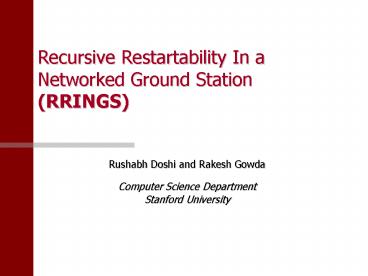Recursive Restartability In a Networked Ground Station (RRINGS) - PowerPoint PPT Presentation
1 / 13
Title:
Recursive Restartability In a Networked Ground Station (RRINGS)
Description:
In conjunction with fault detection, enabling the ground station (GS) for ... Restart implemented as a java System.exec(...) call. Fall 2001 - CS444A ... – PowerPoint PPT presentation
Number of Views:38
Avg rating:3.0/5.0
Title: Recursive Restartability In a Networked Ground Station (RRINGS)
1
Recursive Restartability In a Networked Ground
Station (RRINGS)
- Rushabh Doshi and Rakesh Gowda
- Computer Science DepartmentStanford University
2
Introduction
- Hypothesis
- In conjunction with fault detection, enabling the
ground station (GS) for Recursive Restartability
(RR) will increase system availability - Approach
- Verify the applicability of RR to a single GS
node. - Design a framework for enabling RR in
new/existing GS modules and systems. - Integrate with Fault Detection (FD) component.
3
Current State of Art
- Restart scalpel is a novel approach (Candea ,
Fox). - Sledgehammer Restarts
- MS cluster Server (formerly Wolfpack) uses
clustering and application level restarts to
achieve higher availability. - Unnamed Internet portal does prophylactic
restarts on Apache - However, none of above use an RR scalpel
- We are developing RR scalpel techniques
4
Program Flow
- Wait for a fault message from Fault Detector
- Consult an oracle to tell you what to restart
- Restart those components
- A decision tree is the oracle
- Construct the decision tree
- Capturing restart dependency information
5
RR Tree
- RR Tree captures Restart dependency information
- Parents must be able to restart children
ise
istr
istu
Pipeline
pbcom
fedr
ise IServiceEstimator istr IserviceTracker istu
IServiceTuner fedr FedRadio pbcom
PipelineByteCOMPort
6
From RR Trees to Decision Trees
- Components have different restart times
- Components have different failure rates
- Use this information to augment Decision Tree
- Preserve dependencies
- Reduce MTTR
- Move slower components up, push faster components
down - Capture historical information Groups of
components that fail together - Move high-failure components to single nodes
7
Restructuring helps!
- Sample Restart times for different components
8
Better RR Tree
Pipeline
ise
istr
istu
pbcom
ise IServiceEstimator istr IserviceTracker istu
IServiceTuner fedr FedRadio pbcom
PipelineByteCOMPort
fedr
9
Making the Decision
- Algorithm
- Get a fault, restart the node and children
- May not be able to kill the node
- Restart may not solve the problem
- If this does not fix the problem
- Retry a constant number of times
- Go up one level
- Repeat
- Log all faults and restarts
10
Kill Restart mechanism
- Need for a softer kill
- All components may not be misbehaving
- Give components a chance to free resources
- If soft kill fails, follow with hard kill
- kill 9 system call on linux
- Restart implemented as a java System.exec() call
11
Designing a system for RR
- Goal is to decrease MTTR
- Decompose components into smaller pieces
- Advantages
- Fault isolation
- Move slow-restart pieces up (and fast-restart
down) - Significantly decreases MTTR
- Example fedr and pbom4
- Disadvantages
- Some components may not be decomposable
- IPC can make things difficult (they were together
for a reason) coordination aspect - State management
12
State Management
- Stateful components need to resynchronize after
restart - Resynch complexity is a function of system design
- GS Resynchronization
- All components keep softstate
- Hardstate in control GUI that we are not
modeling here. - Future GS Resynchronization
- Protect system goal state in a safe stable
storage. - Components refresh from this stable storage
- Details not yet defined.
13
Results
- Increased reliability in GS through RR
- Developed framework for enabling new GS modules
- Future work
- Develop protected stable storage techniques
- Extend framework for a multi-component GS
- Extend framework to a federated Virtual GS































